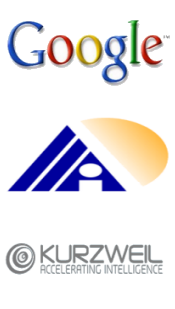Prizes
Kurzweil Prizes
These two prizes, sponsored by KurzweilAI.net for the Fourth Conference on Artificial General Intelligence (AGI-11, Mountain View, CA, August 3-6 2011), were awarded recognize both the Best Overall AGI Paper and the Best AGI Idea of the conference. Each prize was worth $1000.
The 2011 Kurzweil Prize for Best AGI Paper was awarded to Linus Gisslen, Matt Luciw, Vincent Graziano and Juergen Schmidhuber for their paper entitled Sequential Constant Size Compressors and Reinforcement Learning. Their paper was honored for its groundbreaking work bridging the gap between traditional reinforcement learning algorithms and real-world problems. Traditional reinforcement learning methods don’t deal well with “partially observable” environments, yet no real-world intelligence has full knowledge of its environment. The paper describes a novel, creative method of using recurrent neural networks to apply reinforcement learning methods to partially-observable environments — indicating a promising research direction to follow, for those who wish to make reinforcement learning algorithms that scale up to real world problems such as human level AGIs will have to deal with.
The 2011 Kurzweil Award for Best AGI Idea was awarded to Paul Rosenbloom for his paper entitled From Memory to Problem Solving: Mechanism Reuse in a Graphical Cognitive Architecture. Extending the author’s previous work on factor graphs as a core construct for AGI design, this paper shows how factor graph mechanisms described for memory, can also be used for problem-solving tasks. In the human brain there is no crisp distinction between memory and problem-solving, so it is conceptually satisfying to see AGI approaches that also avoid this sort of crisp distinction. It is yet unclear to what extent any single mechanism can be used to achieve all the capabilities needed for human-level AGI; but, it is a very interesting and valuable research direction to take a single powerful and flexible mechanism like factor graphs and see how far one can push it, and Dr. Rosenbloom’s paper comprises a wonderful example of this sort of work.
Solomonoff Prizes
These prizes are named in honor of AGI pioneer Ray Solomonoff. The Solomonoff AGI Theory Prize is awarded to the paper with the strongest contribution to AGI theory, and is worth $1000. Additionally, Solomonoff Student Prizes are awarded to promising students researching AGI to cover travel and registration expenses for the AGI conference.
The 2011 Solomonoff AGI Theory Prize was awarded to Laurent Orseau and Mark Ring, for a pair of papers titled Self-Modification and Mortality in Artificial Agents and Delusion, Survival, and Intelligent Agents. These papers explore aspects of theoretical generally intelligent agents inspired by Marcus Hutter’s AIXI model. The former considers some consequences of endowing an intelligent agent of this nature with the ability to modify its own code; and the latter analyzes aspects of what happens when this sort of theoretical intelligent agent is interfaced with the real world. These papers constitute important steps in bridging the gap between the abstract mathematical theory of AGI, and the real-world business of creating AGI systems and embedding them in the world.
The Solomonoff Student Prizes were awarded to:
Blerim Emruli, Lulea University of Technology, Sweden
Brian Mingus, University of Colorado at Boulder
Daniel Hawthorne, Stanford
Daniel Medina, University of Salzburg, Austria
Irvin Hwang, Stanford
Javier Snaider, University of Memphis
Mark Wernsdorfer, University of Bamberg
Ryan James McCall, University of Memphis
Samuel Epstein, Boston University
Sheng ”Forrest” Bao, Texas Tech
Tom Everitt, Stockholm University, Sweden
Tom Schaul, IDSIA/TU Munich
See here for information on last year’s prize winners.
